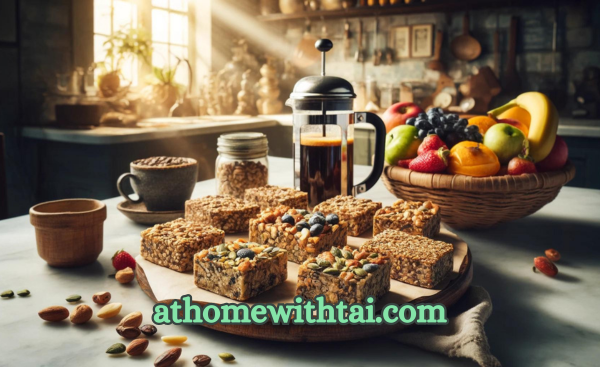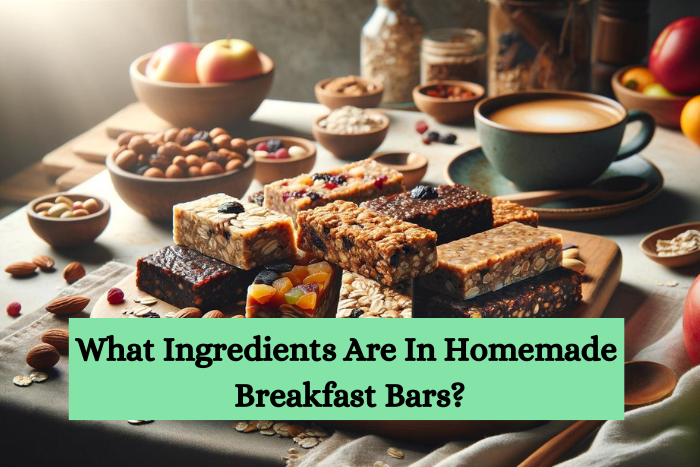- Homemade breakfast bars provide a healthy, customizable alternative to store-bought options, allowing you to control ingredients and avoid excess sugars and preservatives.
- Ingredients for these bars include whole grains like oats or quinoa for fiber, natural sweeteners like honey or maple syrup, healthy fats from nuts or seeds, and proteins such as whey powder or chia seeds, echoing the balanced nutrition you’d find in a well-rounded homemade granola.
- The process of making breakfast bars at home involves choosing ingredients that not only taste good but also provide sustained energy, much like selecting a combination of fruits, nuts, and cereals for a trail mix that you might take on a long hike.
- Adapting breakfast bars to meet specific dietary requirements, such as gluten-free, vegan, or nut-free options, is straightforward.
- Not skipping breakfast and leveraging the practicality and nutritional benefits of homemade bars will enhance morning routines, similar to how a coffee aficionado might prepare a quality espresso at home to ensure a perfect start to the day.
Everyone agrees a hearty breakfast sets the stage for a productive day. But mornings can be hectic, and it’s easy to prioritize convenience over nutrition.
That’s where homemade breakfast bars come in handy. These compact, easy-to-eat options are not only great for on-the-go mornings but also for those seeking a quick, healthy bite before starting their day.
Compared to their store-bought counterparts, homemade bars have a clear edge. By making your own, you control the ingredients, cutting out excessive sugars and preservatives.
🌟 Benefits of Homemade vs. Store-Bought 🌟 |
|
|---|---|
| Homemade Breakfast Bars | Store-Bought Breakfast Bars |
| 👌 Full control over ingredients | ❓ Often contain preservatives and added sugars |
| 🍃 Can make them organic or non-GMO | 🚫 Limited organic options |
| 🎨 Completely customizable (flavors, add-ins) | 🔄 Limited to available flavors and brands |
| 💰 More cost-effective in the long run | 💸 Can be more expensive per serving |
| 🌱 Healthier with no unnecessary additives | 🔍 May contain artificial flavors and colors |
| Brought to You by athomewithtai.com | |
This means your morning boost is not only healthier but tailored to your personal taste and dietary needs. So what goes into these homemade health champions?
Typically, a combination of whole grains, nuts, fruits, and proteins make up the core of these bars, with natural sweeteners and healthy fats rounding out the flavors and nutritional profile. The result is a wholesome, satisfying bar that serves as a perfect kickstart to a busy day.
After understanding the basics and benefits of homemade breakfast bars, you’ll be eager to mix and match ingredients to suit your palate. Ready to find out how to make these nutritious snacks a staple in your morning routine?
Let’s look at the essential ingredients you’ll need for your own energy-boosting creations.
And remember, please don’t skip breakfast!
Essential Ingredients for Your DIY Morning Fuel

Homemade breakfast bars are more than just convenient; they’re powerhouses of nutrition that can give you an excellent head start to a busy day. The beauty of making them at home is the full control you have over the ingredients, ensuring every bite is packed with the goodness you need.
Here’s a primer on what goes into these bars to make them both flavorful and fueling. For a robust structure, whole grains are a staple.
They offer a reliable base while packing in fiber, which aids in digestion and keeps you full longer. Oats are a popular choice, but don’t overlook other grains like quinoa or puffed brown rice, which can add a delightful crunch.
The sweetness in your breakfast bars should come from natural sources. Honey and maple syrup are excellent because they’re unrefined and contain more nutrients than white sugar.
For those looking for lower glycemic index options, date paste can sweeten things up without causing a rapid spike in blood sugar levels. Fats are essential, but choosing the right ones matters.
Nuts and seeds serve a dual purpose, providing not only the necessary fats for sustained energy but also contributing protein and a satisfying texture. Nut butter can also help in binding the ingredients together, offering richness and depth of flavor.
Protein is non-negotiable for a breakfast that keeps hunger at bay. Whey powder is a dense source of protein for those who consume dairy, but plant-based options like chia or hemp seeds are fantastic for everyone, packing in the protein along with beneficial omega-3 fatty acids.
Speaking of binding, you’ll need something to hold these bars together. Eggs are a traditional binder, but mashed banana or applesauce can be your friend if you want to keep it plant-based.
These not only help with structure but also add moisture and natural sweetness. Finally, flavor is key.
Spices like cinnamon and vanilla extract or a sprinkle of cocoa powder can elevate the taste of your breakfast bars. Each brings its unique profile, and beyond taste, they come with their own set of health benefits, adding an extra layer of value to your morning munch.
And don’t forget your breakfast drink!
Customizing Your Breakfast Bars: Tips and Tricks for Tailored Taste

Tailoring your homemade breakfast bars to your personal taste or dietary needs doesn’t have to be complicated. It’s an opportunity to get creative and enjoy a variety of flavors while still keeping that practical edge.
Whether you’re catering to gluten intolerance, following a vegan diet, or simply looking for a nut-free snack, there’s a multitude of alternatives at your disposal. For those needing gluten-free options, grains like quinoa or gluten-free oats are ideal starters.
Vegan eaters can opt for flax eggs or mashed bananas instead of regular eggs for a plant-based binder. If nuts pose an allergy issue, seeds like sunflower or pumpkin can offer that satisfying crunch without the worry.
Don’t forget the mix-ins that make every bite interesting. Dried fruits like cranberries or apricots can introduce a sweet tang, while a few chocolate chips indulge your sweet tooth responsibly.
If you love the tropics, sprinkling in some shredded coconut might do the trick. Remember, fresh is best.
To maintain freshness, store your bars in an airtight container and keep them in a cool, dry place. If you’ve made a big batch, freezing is also a practical option to consider.
My Final Thoughts
The mark of any good recipe is adaptability. Use these suggestions as a foundation and don’t be afraid to experiment.
Test with various ingredients or spices until you find what suits your palate. Regardless of your choices, the pathway to a wholesome, delicious breakfast bar is at your fingertips.
Get into your kitchen, and start pressing those bars – your mornings are about to become a whole lot more enjoyable. How do you think making your own breakfast bars could change your morning routine, and what unique ingredients would you include to personalize them to your tastes and nutritional needs?
Let me know in the comments below!
FAQ for Homemade Breakfast Bars

1. What are the benefits of making your own breakfast bars?
- Healthier Options: When you make your own breakfast bars, you control the ingredients, allowing you to reduce sugar and eliminate preservatives and additives found in many store-bought options.
- Customization: Homemade bars can be tailored to meet personal dietary needs and flavor preferences, whether you’re accommodating allergies, following a specific diet, or just preferring certain tastes.
2. What are some essential ingredients for homemade breakfast bars?
- Base Ingredients: Whole grains like oats, quinoa, or puffed rice provide a solid foundation and important nutrients like fiber.
- Binders and Sweeteners: Natural sweeteners like honey or maple syrup add flavor, while binders such as eggs, mashed bananas, or applesauce help hold the bars together.
3. How can I make my breakfast bars vegan or gluten-free?
- Vegan Alternatives: Replace eggs with flaxseed meal or mashed bananas to bind the ingredients. Use plant-based proteins like hemp seeds or pea protein to boost nutritional content.
- Gluten-Free Options: Opt for gluten-free oats or grains like quinoa. Always ensure that all other ingredients used, such as baking powders or flavorings, are certified gluten-free.
4. What are some creative mix-ins for breakfast bars?
- Fruits and Nuts: Dried fruits like cranberries, apricots, or dates add sweetness and texture; nuts and seeds provide crunch and healthy fats.
- Flavor Enhancers: Spices like cinnamon or nutmeg, vanilla extract, or a sprinkle of cocoa powder can enhance the flavor of your bars, making them even more enjoyable.
5. How should I store homemade breakfast bars, and how long do they last?
- Storage: Keep your breakfast bars in an airtight container at room temperature for up to a week, or refrigerate them to extend their shelf life.
- Freezing: For longer storage, wrap the bars individually and freeze them. They can be thawed overnight in the refrigerator or briefly warmed in a microwave for a quick breakfast.
- Why Are Breakfast Juices a Smart Choice?
- What’s the Best Beverage for Diabetics at Breakfast?
- What’s the Best Protein Drink for Your Morning Routine?
- Can Breakfast Drinks Really Boost Your Weight Loss?
- Ever Tried Turkish Coffee or Indian Lassi?
- Is Your Morning Drink Boosting Your Health or Calories?

I’m Diane, a culinary enthusiast who loves to share my cooking adventures and knowledge with you.
This blog is my cozy corner on the internet where I unravel the secrets behind making everyday cooking simple, enjoyable, and downright delicious.
Whether it’s unlocking the flavor potential in chicken or figuring out why your mashed potato cakes won’t hold together, I’m here to guide you through.
Join me as we explore various dishes, solve common kitchen dilemmas, and discover new recipes that will make you fall in love with cooking all over again.
Cooking is an adventure that’s best shared, so let’s get started!







